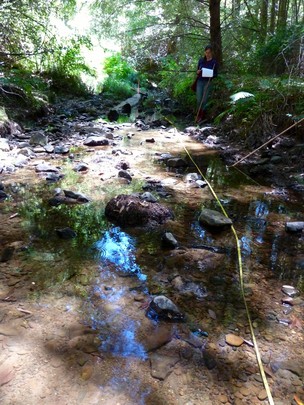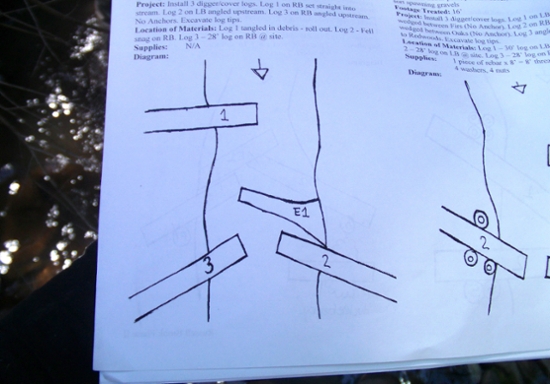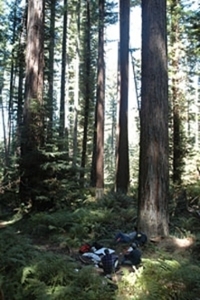The Siegel Salmon Restoration Internship: Part 2

Figure 1. In-stream measurements at Russell Brook. Although picturesque, the stream is not very hospitable for rearing and migrating salmon.
The large woody debris project forges ahead here at the Mendocino Land Trust. Two weeks ago, I went into the stream at Russell Brook along with Doug (Big River Program manager) and Nicolet (Trails & Stewardship Coordinator). We walked the length of the project area (about a half mile) and took some basic stream measurements (Figure 1) that quantitatively describe the area and determine the baseline level of viable salmon habitat. Spoiler alert: it’s pretty low. Pools are infrequent and shallow, meaning that salmon don’t have good rearing habitat, and cannot rest during upstream migration. Water temperature is high, which poses a problem for these cold-water inhabitants. However, only a couple hundred feet up the stream, where large woody debris has already been installed, deep pools swell over the tops of waders (a bittersweet discovery).
The California Conservation Corps (CCC) has now begun the arduous process of hauling and anchoring huge logs in the stream according to detailed plans (Figure 2). I’ll get to see the crews in action in a couple weeks while conducting an inventory of the large woody debris that is in place.
 Figure 2: Large woody debris plans developed by the California Conservation Corps.
Figure 2: Large woody debris plans developed by the California Conservation Corps.
Meanwhile, I spend my days composing a report of our findings. It has been a fun challenge to translate manuscript-writing skills from courses like microbiology and behavioral neuroscience into the context of habitat restoration. While subjects like metabolic peptides and psychostimulants aren’t exactly similar to large woody debris and salmonid habitat, the writing process is not all that different.
In addition to my central project, I have learned about the daily life of the Land Trust by participating in different facets of the organization. The Mendocino Land Trust annual meeting was a great opportunity to discuss the organization’s recent accomplishments and future projects, and meet with community members who are passionate about land conservation. I also helped prepare outreach material for the “World’s Largest!” Fort Bragg Salmon BBQ, which is sponsored by the Salmon Restoration Association. Thousands of people turn out for the event, which features live music, delicious food, and general enthusiasm about salmon. One of my favorite tasks was sifting through material about the mystical-sounding Fritz Wonder Plot (I initially imagined an entirely different spelling: fritzwünderplat). This is an area of dense second-growth redwoods, which has been protected and surveyed since the 1920s (see Figure 3). The plot is a gem for redwood enthusiasts and researchers alike, allowing us to understand the redwood life cycle and growth rate at an incredible level of detail. As preparations for the 2015 meeting are underway, I was excited to give my two-cents on this exciting project. 
Figure 3. Surveyors take a break from their day of monitoring (Mendocino Land Trust, 2005).
A fellow Reedie, Lydia Kerns, has been visiting for the past week, giving me the opportunity to see the region anew; we have visited my favorite bookstores, cafes, and hiking trails. Showing her around makes me realize that Fort Bragg and Mendocino have come to feel more like home. I’m looking forward to another month in this beautiful coastal town, and continuing work with the Mendocino Land Trust.
Tags: internship advantage, salmon, conservation
